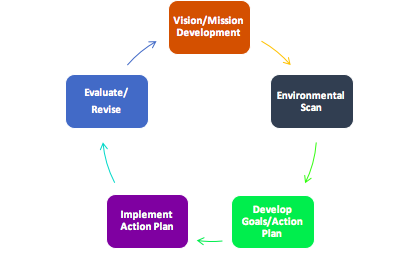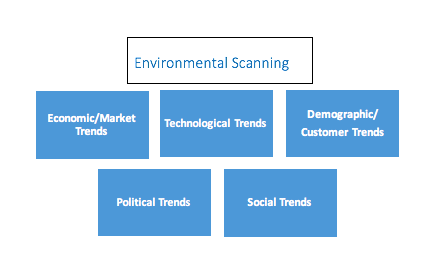Overview of Leadership Information: LMI
Vocational rehabilitation (VR) leadership provides the foundation and direction for their agency when new initiatives are introduced. The Workforce Innovation and Opportunity Act (WIOA) places an emphasis on effective use of labor market information (LMI) by VR agencies in the future. As with any change, leadership must anticipate, strategize for, communicate about, and train their staff to address this emerging need.
This section offers resources to help VR leadership:
- Create structures, protocols, and practices to support the effective use of LMI at all levels within the agency.
- Ensure counselors have the information, training, systems, and support needed to incorporate robust LMI use into their day-to-day work.
- Analyze the role that LMI vendors play within the VR organization relative to the use of LMI for VR consumers.
- Analyze the VR case management system to determine if it enhances or inhibits use of LMI.
- Ensure the state rehabilitation council is informed and aware of the importance of LMI integration into VR processes.
- Create memoranda of understanding that maximize access to LMI between the VR agency and its partner agencies under WIOA.
- Develop a system of LMI that is internal to the state VR agency. This might involve a database that collects or tracks LMI data, and/or investment in a tool that integrates different types of LMI (traditional, real-time, on-the-ground intelligence)—and that can be integrated into case management systems.
As WIOA regulations are developed and released, we will update this section with:
- Specific educational and experiential criteria that must be met by VR personnel.
- Definitions and guidance regarding “a 21st-century understanding of the evolving labor force and needs of individuals with disabilities.”
- Modified requirements of the VR agency as partner entity within the Workforce Innovation and Opportunity System.
- Leadership community of practice documents and information.
Webinar View the ExploreVR webinar, Labor Market Information (LMI) for VR Leadership in the Age of WIOA: A View from the Top.
Labor Market Information and Strategic Planning
For leaders in state vocational rehabilitation (VR) agencies, labor market information, or LMI, can be more than a required response to the Workforce Innovation and Opportunity Act (WIOA). It can also help VR agencies with their strategic planning efforts.
As described on ExploreVR, LMI consists of traditional and real-time sources, as well as agency-generated sources of information gathered through relationships with employers.
- Traditional LMI: The systematic collection, analysis, and reporting of a broad range of federal, state, and local data that describes current economic conditions within a given geographic area. Key data metrics include current employment levels, projected employment growth, unemployment rates, average wages, minimum education requirements, industry trends, and workforce demographics.
- Real-time LMI: Data drawn from online job postings for a region, offering information on employer demand, new and emerging in-demand skills and credentials, job titles, industry trends, and educational requirements.
- Agency Business Relations LMI: Qualitative information gathered from employers, chambers of commerce, and industry associations about opportunities and challenges of hiring for different positions, expected changes in employment, and positions that require specialized skills.
All three types of LMI can be valuable for counselors and placement specialists working with consumers. That same information can also help VR leaders in determining the future direction of their agency’s efforts to improve customers’ labor market outcomes, train counselors on the use of LMI, incorporate LMI into case management systems, and cultivate strong employer and education partnerships.
Many VR agencies will engage with workforce partners to develop statewide strategies to capitalize on LMI. As VR prepares to engage as an effective partner, it is essential for its leadership to understand LMI and its impact on agency effectiveness.
Successful organizations often employ strategic planning processes. A key element in the process is to engage staff so that their concerns, insights, and feedback are included in the plan. Some states have included an assessment process in their planning to determine their staff’s use of and interest in LMI. This information can help determine potential engagement and training strategies.

The overall strategic planning process includes completing an environmental scan. The businessdictionary.com website defines environmental scanning as “Careful monitoring of an organization's internal and external environments for detecting early signs of opportunities and threats that may influence its current and future plans.”
Typically, environmental scans look at economic, political, social, technological, market, customer, and demographic information and trends as shown in the following:

Labor market information can be a vital part of the environmental scanning process. LMI can provide information on new major businesses coming into the state or region, with which the VR leader may want to develop a direct relationship. This information can also help determine which industries may be leaving the area, prompting VR leaders to plan for eligible individuals who may need new jobs, and to notify their staff about regional employment losses that could have major impacts on consumers.
By looking at LMI trends, leaders, along with staff, can develop sector strategies. Sector strategies are multifaceted collaborations between VR and local employers, workforce agencies, and educators within sectors that are foundational to the economic health of a region.
LMI can help to determine the most successful sectors on which to focus resources and efforts. For more information, view the ExploreVR webinar, Sector Strategies: What are they and how can they help VR agencies?. The Employer Supports and Business Engagement toolkits also include information about sector strategies.
LMI is consistently updated on an operational level by VR agency staff outside of the formal strategic planning process. VR leaders can also use formal LMI reports to provide global insight to staff about assisting consumers in finding higher paying jobs, identifying local and less expensive training options, and understanding the competition for specific jobs in local areas.
Another important reason for leaders to review LMI is to work with staff in determining customized training options best suited for the state/region. Additional information on customized training can be found in the Customized Training toolkit.
All LMI can be translated into goals and action steps as part of the agency’s formal or informal strategic plan. As the labor market evolves, LMI is being updated constantly. This makes it invaluable in the evaluating and revising portion of the strategic planning cycle.
Competencies for VR Use of LMI
While Labor Market Information (LMI) has been used by vocational rehabilitation (VR) agencies to varying degrees over the years, with the passage of the WIOA legislation, there is an expectation that LMI will play a more critical role in VR services. We have outlined recommended LMI competencies that VR staff may need to respond to these guidelines and integrate LMI into the work of their agency.
LMI will be used in different ways and for different purposes in VR agencies, depending on internal agency structures and staffing configurations. There will be variation across agencies on how LMI is gathered, stored, analyzed, and shared across the agency, and how staff may integrate the use of LMI in their work as leaders, managers, and counselors.
For example, in some agencies LMI is gathered and analyzed through a single point of contact in the central office, who will then coordinate with regional business account managers. Other agencies may have staff using LMI in local offices working more autonomously, acting as liaisons between employers, the local office, and clients.
Regardless of the model or a given staff person’s role, having LMI knowledge and competency within the VR organization is crucial in creating connections that can improve employment outcomes.
In VR agencies, LMI is routinely used in the following ways:
- Helping individuals with disabilities to identify career goals that offer ample opportunities for employment at a living wage.
- Writing Individualized Plans for Employment that promote informed choice in setting a goal for jobs that are currently available and/or have expected future availability.
- Determining available training, education, and job placement opportunities, both current and anticipated.
- Referring to and/or developing training programs in high-demand fields with local training providers like community colleges.
- Networking with and engaging business partners for successful job matching and placement.
- Providing information about employment options that meet the financial needs of persons with disabilities.
We have organized these LMI-related competencies into four categories based on common staff functions, dependent on their role within the organization. There may be some overlap among the various positions depending on a specific VR agency’s configuration.
| Business Account Manager: Leadership/Supervisory Role (Central Office role in the agency) | Business Account Coordinator: Direct Business Recruitment and Engagement | Business Specialist/Job Developer: Liaison with Employer and Client | Vocational Rehabilitation Counselor/Rehabilitation Technician |
|---|---|---|---|
|
|
|
|

